Just a couple of weeks ago I released version 0.5 of Food Chain Farm! This release has been a year in the making and has a ton of new stuff. Today, I want to dive deeper into one aspect: the improved art style.
The game has a lot of graphics, more than any other game I’ve done before. Dozens of plants, animals, resources and other objects, all drawn in detailed vector graphics. And it’s a huge challenge for me. I’ve always been programmer first, graphical artist second (and music is even further down the list…). For most games I worked on in the past, I’ve either limited myself to a small amount of pixel art, or I’ve outsourced the artwork to a partner. They say you need to put in 10000 hours to become really good, and I’m afraid I haven’t put those hours in yet…
And there are so many beautiful indie games out there. It’s hard not to feel discouraged when there are so much awesomeness to compare with. Nevertheless, I’m going to stick with it. I’ll be the first to admit that this art style is a work in progress. But with the 0.5 release, for the first time I’m happy with the direction things are going.
As an example, let’s look at how one item in the game has evolved over the past years:

The apple tree has been in the game right from release 0.1, back in 2018, and I put it together quickly in Inkscape, from basic geometric shapes. The foliage is just the union of bunch of circles, the trunk was drawn as a polygon using the mouse. Inkscape makes it easy to adjust the curve of a given line, so I made the sides of the stem curve inwards. The apple itself is a modified circle, with a green-red-white radial gradient to give it a nice shine. I added a short brown line for the stem of the fruit. To top it all off I gave the foliage a gradient as well, as a cheap way to give it some highlights and shadow.
This was always meant to be a placeholder, to get going quickly – it was never the intention that this would make it into the final game. But coming up with a better version took longer than I thought.
I’ve experimented with various methods e.g. using a Wacom tablet, using the ‘trace sketch’ function in Inkscape, with mixed results. In the end I settled on a much simpler process: I first sketch on paper, I scan it, and then trace the sketch with the mouse, in Inkscape. The result looks like this.

For inspiration and examples, I use images from the internet of course. But in this case I could actually take inspiration directly from my environment. I live next to a small orchard, and there is this nice old apple tree right in front of my house. The trees tend to be pruned to a flat wide shape (I guess it’s easier to pick apples that way) and end up with crooked, gnarly looking branches. It’s something that I tried to mimic in this sketch.
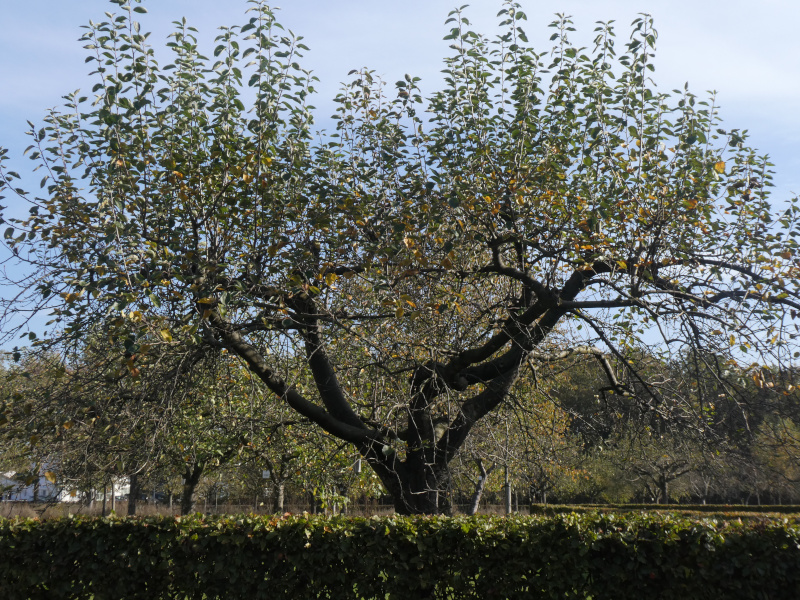
The sketching phase is important. I’ve learned that I’m much better at coming up with ideas on paper first. Sketching digitally doesn’t work well for me. And over time, my sketches have developed in a certain way. I’m making them more elaborate, trying to add more character, but at the same time I make them looser, more playful. I spend less effort making the sketches very precise. I don’t worry about the exact lines until I digitize the sketch in Inkscape.
To see what I mean, take a look at this bunny character. I started with a few quick sketches. These were drawn after photos and have realistic proportions.
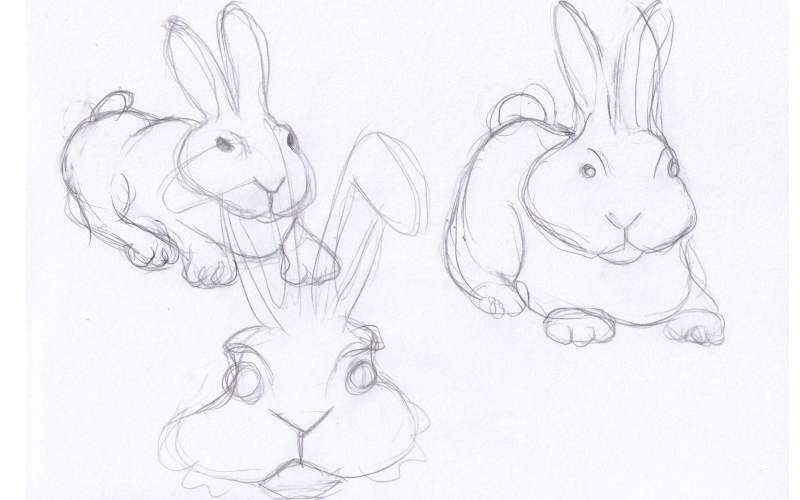
Compared to, say, a cow or a pig, bunnies have a relatively small, narrow face. And, of course, large ears. By giving the head a more exaggerated shape, narrow at the eye level, and oversized ears, the essence of the character becomes more rabbity. I switched to a frontal perspective, this is a common theme for all animals in the game.
 I’ve tried to become less rigid, using more round curves instead of straight lines, even for things that ought to be straight. Take a look at the new oven drawing for example. Here I exaggerated the roundness of the countertop and the brick sides.
I’ve tried to become less rigid, using more round curves instead of straight lines, even for things that ought to be straight. Take a look at the new oven drawing for example. Here I exaggerated the roundness of the countertop and the brick sides.
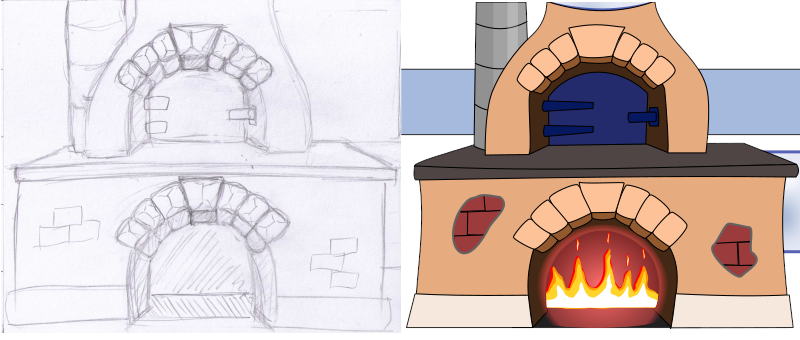
Below you see some sources of inspiration. The picture on the left is from Anton Pieck. This Dutch artist is known for a romantic style, with old fashioned candy shops, life-worn houses and snow-covered Christmas villages. His paintings put a lot of detail in building materials, making them atmospheric and full of character. I grew up with this art style – he was the original designer for the Efteling theme park, where I visited frequently as a kid. The image on the right is from the game Oxygen Not Included (ONI). I love this game for the art style. Everything is full of character. Ladders, pipes, walls and floors – things that really should be straight – are higgledy-piggledy. ONI takes creative liberties to give it a unique character. By the way, ONI has more things in common with Food Chain Farm – more on that in a later post.
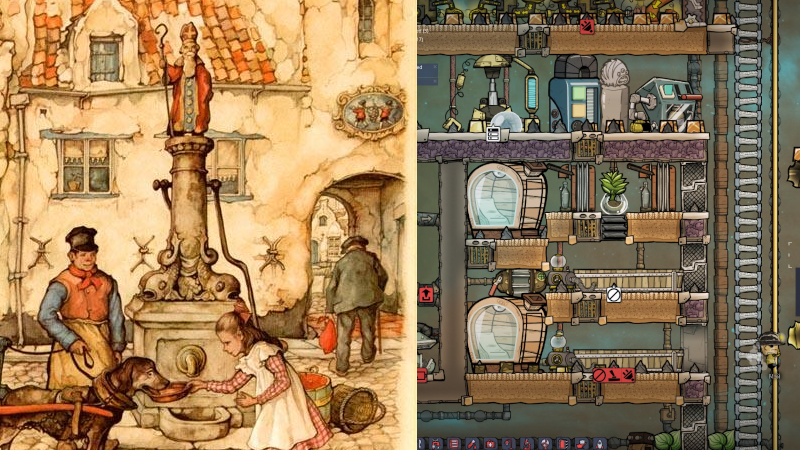
Also, to get more practice (to get those 10000 hours if you will), I’ve been taking some live model drawing classes. The pictures below were taken during a socially distanced drawing class this summer. Drawing live models is great sketching practice. You have to be quick – the model can hold a pose only for so long. One common warm-up exercise is to draw a succession of poses in two minutes. It seems impossible at first, but you really get better with practice.

Of course, for the game, I can change proportions for a more cartoony appearance. Here are some sketches I’m working on, for a future version of the game.
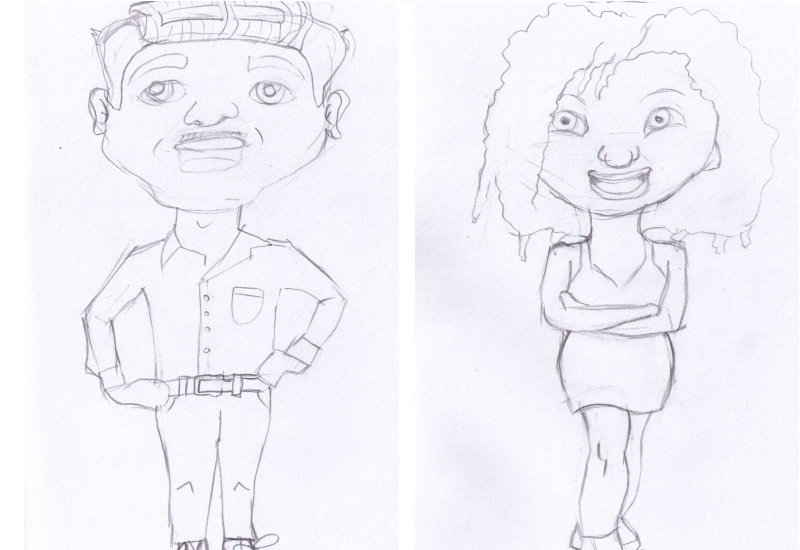
Have a look for yourself, Food Chain Farm 0.5 can be downloaded from itch.io!

